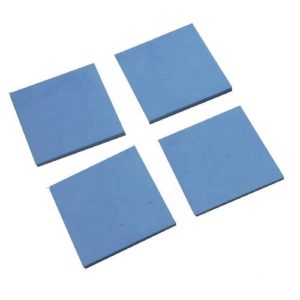The difference between the double-sided adhesive and the single-sided adhesive of the thermal conductive silicone pad!
xinstMar 08, 2021
Thermally conductive silica gel sheet is a kind of thermally conductive medium material synthesized by special process with silica gel as the base material and various auxiliary materials such as metal oxides. Thermally conductive silicone rubber is a polymer composite material that uses silicone resin as the bonding material and is filled with thermally conductive silicone pad powder to achieve the purpose of heat conduction.
Classification of thermal silica gel
Thermally conductive silicone can be divided into: thermally conductive silicone gasket and non-silicone silicone gasket. The electrical insulation properties of most thermally conductive silica gels are ultimately determined by the insulation properties of the filler particles.
1. Thermally conductive silicone gasket
Thermally conductive silicone gaskets are divided into many sub-categories, each with its own different characteristics.

2. Non-silicone silicone gasket
Non-silicone silicone gasket is a material with high thermal conductivity. It is self-adhesive on both sides. When used in the assembly of electronic components, it shows lower thermal resistance and better electrical insulation characteristics under low compression force. It can work stably at -40℃~150℃. Meet the flame retardant grade requirements of UL94V0.
The difference between adhesive and non-adhesive thermal silicone gasket
Thermally conductive silicone gaskets are an indispensable member of thermal conductive materials. At the same time, thermally conductive silicone gaskets can be adhesive-backed or non-adhesive, so what is the difference between adhesive-backed and non-adhesive?
Thermal conductive silicone gasket double-sided adhesive:
The double-sided adhesive is mainly because the product has no fixing device or is inconvenient to fix. The double-sided adhesive can be used to fix the radiator, stick the IC and the heat sink, and there is no need to design a fixed structure.
Benefit: It can be used to fix the radiator, no need to design a fixed structure.
Impact: The thermal conductivity will be worse, and the derivative coefficient will be much lower.
Single-sided adhesive for thermal conductive silicone gasket:
Single-sided adhesive is mainly to facilitate the installation and bonding of thermal silica. For example, a backlight source uses thermal silica with a size of 400*6, which is not easy to install. Therefore, single-sided adhesive should be used, and the thermal silica is glued. One side is attached to the PCB board, and the other side is attached to the housing.
Benefit: It can stick to the surface of the heater on one side. When the radiator or the shell slides relatively during the assembly process, the thermal conductive silicone gasket will not cause position shift.
Effect: The thermal conductivity will be lower, but the effect is better than double-sided adhesive.
To sum up, whether it is a double-sided adhesive or a single-sided adhesive for thermally conductive silicone gaskets will result in lower thermal conductivity, but it is conducive to structural design and installation.


